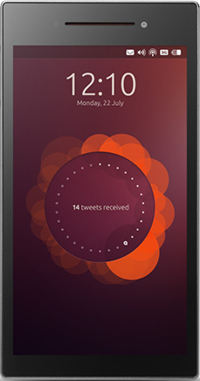 Preview of Ubuntu Touch on a Ubuntu Edge (render) | |
| Brand | Canonical Ltd. |
|---|---|
| Type | Smartphone |
| Form factor | Touchscreen |
| Dimensions | 124 mm (4.9 in) H 64 mm (2.5 in) W |
| Operating system | Ubuntu Touch and Android (Dual boot) |
| Memory | 4 GB |
| Storage | 128 GB |
| Battery | rechargeable silicon-anode Li-ion |
| Rear camera | 8 MP optimized for low light photography |
| Front camera | 2 MP |
| Display | 4.5 in (110 mm) diagonal 1280×720px (326 ppi) 16:9 aspect-ratio |
| Connectivity | 3.5 mm TRRS Dual-LTE GSM GPS MHL Bluetooth 4 NFC Wi-Fi 802.11a/b/g/n |
| Data inputs | Touchscreen Accelerometer Gyroscope GPS Barometer Digital compass Proximity sensor Dual microphones for active noise cancellation |
| Other | Sapphire crystal display screen, stereo speakers |
The Ubuntu Edge was a proposed high-concept smartphone announced by Canonical Ltd. on 22 July 2013. Canonical was seeking to crowdfund a production run of around 40,000 units through Indiegogo. It had the highest target of any crowdfunded project to date, $32,000,000 over a one-month campaign. The Edge was not intended to go into mass production after the initial run, but rather to serve as a demonstration for new technologies for the industry. The Edge fell short of its funding goal, raising only $12,733,521 with 27,633 backers to purchase the standard model of the handset.[1]
The Edge was designed as a hybrid device, which would function as a high-end smartphone (with both Ubuntu Touch and Android), or—when used with a monitor, keyboard and mouse—be able to operate as a conventional desktop PC running Ubuntu.[2] The Ubuntu Edge was also designed to support dual boot, and was to run along with Android.[3]
- ^ "Canonical announcement on Indiegogo". Indiegogo. 22 August 2013.
- ^ Kelion, Leo (22 July 2013). "Ubuntu Edge smartphone seeks $32m of crowdfunded cash". BBC News. Retrieved 22 July 2013.
- ^ Ubuntu Edge : Bringing Magic To the Smartphone Archived 6 August 2013 at the Wayback Machine. Top Net Tools, Retrieved 28 July 2013.